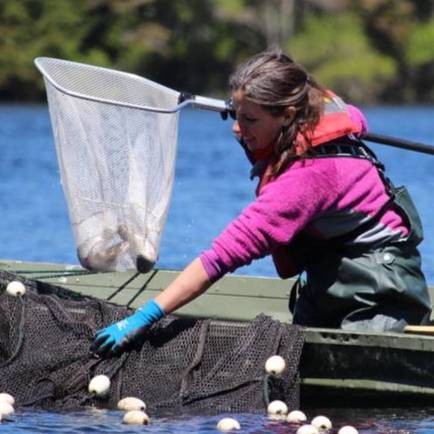Phytoplankton May Not Be as Resilient to Changes in Ocean Temperature
Phytoplankton, microscopic photosynthetic organisms floating in oceans and lakes, are responsible for half of all oxygen production on earth—a number equal to terrestrial plants, and a fact that is easy to forget.
“For every second breath you take, you can thank phytoplankton,” said Elena Litchman, MSU Foundation Professor of Integrative Biology in the College of Natural Science and Kellogg Biological Station (KBS) faculty member, who has been conducting research into the environmental factors that influence phytoplankton productivity and community composition for over 25 years. “We simply cannot live without these and other microbes.”
Many scientists may also have been taking these single-celled organisms for granted by assuming that their large population sizes and short generation times will allow them to readily adapt to increases in ocean temperature.
In a study recently published in Ecology Letters, former KBS postdoctoral researcher María Aranguren-Gassis and a team of KBS scientists led by Elena Litchman questioned this widely held belief that evolution will rescue phytoplankton species from changes in climate.
The problem is that multiple different factors contribute to stressing out phytoplankton and other microbes.
“It is predicted that nutrient limitation in the oceans will increase as the climate warms,” Elena said. “The upper layer will warm, causing reduced density and subsequently reduced mixing of ocean layers that supply nutrients from the deeper layers to the sunlit layers where phytoplankton live.”
In the future, nutrient distribution in lakes and the oceans will be highly uneven. Some parts of the open ocean will become more nutrient-limited, while other parts, like coastal oceans and inland lakes, will probably have higher nutrient levels.
“We noted in previous studies that interacting stressors such as nutrient limitations coupled with higher temperatures can modify species’ physiological reactions,” Elena explained. “We found that when phytoplankton species are nutrient-limited, their optimal temperature shifts to lower temperatures.”
With this new information in hand, the research team set out to test the hypothesis that the interaction of decreased nutrients coupled with a rise in ocean temperature would also influence the ability of phytoplankton to undergo evolutionary change. Their hypothesis was correct.
“Previous studies did show that different microbes can adapt to higher temperatures and other stressors, but they were done under ideal growth conditions in the lab,” Elena said. “It seems that ours is the first one to show that stressor interactions can inhibit adaptation to higher temperature. It leads us to conclude that in the future, when there is more nitrogen limitation in the ocean, we cannot just assume phytoplankton species are not in danger. They may not be able to adapt because of nutrient limitation.”
One of the paper’s strengths is its combination of experiments and theoretical modeling. Elena Litchman and first author Aranguren-Gassis, now a distinguished researcher at the University of Vigo, Spain, conducted the experimental piece of the ground-breaking research.
Theoretical ecologist and KBS professor of plant biology, Christopher Klausmeier, and Colin Kremer, KBS postdoctoral researcher, both co-authors, developed the novel, eco-evolutionary model that helped explain their experimental results.
“Our model lets phytoplankton invest in proteins that protect against high temperatures, weighing the benefits against the costs,” Christopher Klausmeier explained. “Since proteins contain lots of nitrogen, these protective proteins are cheap to build when nitrogen is abundant but costly when nitrogen is in short supply. We think that this extra expense prevents phytoplankton from adapting to high temperatures when nutrients are limiting.”
“There is a movement in our field to look not just at individual stressors but interacting stressors, because there is no situation where just one variable changes,” Elena Litchman said. “With the global environmental change, we have rising temperatures, ocean acidification, changes in precipitation and changes in nutrient regimes all happening at once. Scientists are now realizing that we need to look at stressor interactions and how they determine both ecological and evolutionary responses of species to a changing climate.”



